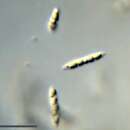en
names in breadcrumbs


Die Comamonadaceae sind eine Bakterien-Familie, die zur Ordnung der Burkholderiales gehört.[1]
Fast alle Vertreter der Comamonadaceae sind aerob und chemoorganotroph. Die meisten Arten sind durch den Besitz von Flagellen beweglich. Es kann sich um ein einzelnes Flagellum handeln, wie z. B. bei Acidovorax und Hydrogenophaga, auch Arten mit Büschel von Flagellen (polytrich) sind vorhanden. Beispiele für Büschel die entweder an beiden polaren Enden (polytrich-bipolar) oder nur an einem Ende (polytrich-monopolar) auftreten sind Delftia acidovorans und Arten von Comimonas. Variovorax ist peritrich (gleichmäßig verstreut) begeißelt. Brachymonas besitzt keine Flagellen.[2]
Die Zellmorphologie ist meist stäbchenförmig, es kommen aber auch Arten mit gekrümmten Stäbchen vor. Auch Arten mit spirillenförmigen Zellen sind in dieser Familie vorhanden, wie z. B. Arten von Comamonas. Die Gram-Färbung fällt negativ aus.[2]
In der Familie der Comamonadaceae ist eine Vielfalt von Stoffwechselwegen anzutreffen. Der Stoffwechsel ist meist chemoorganoheterotroph. Der terminale Elektronenakzeptor ist Sauerstoff (Atmung). Allerdings sind auch anaerobe Denitrifikatoren, photoautotrophe und photoheterotrophe Arten vorhanden. Auch fermentative Vertreter sind anzutreffen. So kann Brachymonas denitrificans wenn kein Sauerstoff vorhanden ist, also unter anaeroben Bedingungen, Nitrat als Akzeptor nutzen (Denitrifikation, auch als Nitratatmung bezeichnet).[3]
Die Art Acidovorax facilis kann auch chemolithoautotroph wachsen, sie nutzt hierbei molekularen Wasserstoff (H2) als Energiequelle und Kohlendioxid als Kohlenstoffquelle. Diese Art wurde zuerst von Albert Schatz im Jahr 1952 beschrieben und unter den Namen Hydrogenomonas facilis geführt, wobei der Gattungsname Hydrogenomonas auf die Besonderheit der Oxidation von Wasserstoff zur Energiegewinnung hinweist (Hydrogenium ist der lateinische Name für Wasserstoff).[4] Später wurde die Art zu der Gattung Pseudomonas gestellt und im Jahre 1990 dann von A. Willems in die Gattung Acidovorax transferiert.[5]
Auch einige Arten von Hydrogenophaga sind chemolithoautotroph und können Wasserstoff oxidieren. Andere Arten der Gattung oxidieren Thiosulfat zu Sulfat, sie zählen zu den schwefeloxidierenden Bakterien, auch Sulfurikanten genannt. Einige Vertreter von Hydrogenophaga, wie z. B. die stäbchenförmige Art H. bisanensis, nutzen unter anaeroben Bedingungen Nitrat als terminalen Elektronenakzeptor (Nitratatmung).[6] Einige Stämme von H. pseudoflava können molekularen Stickstoff (N2) fixieren.[3]
Gattungen der Familie sind:[7]
Die Comamonadaceae sind eine Bakterien-Familie, die zur Ordnung der Burkholderiales gehört.
The Comamonadaceae are a family of the Betaproteobacteria.[3] Like all Pseudomonadota, they are Gram-negative. They are aerobic and most of the species are motile via flagella. The cells are curved rod-shaped.[4]
The Comamonadaceae are a family of the Betaproteobacteria. Like all Pseudomonadota, they are Gram-negative. They are aerobic and most of the species are motile via flagella. The cells are curved rod-shaped.
Comamonadaceae es una familia de Proteobacteria.
Les Comamonadaceae sont une famille de protéobactéries à coloration Gram négative de l'ordre des Burkholderiales, qui comprend une trentaine de genres.
Certains représentants de la famille des Comamonadaceae ont été isolés du sol, de la boue, de l'eau et d'environnements industriels ou terrils miniers. Certaines espèces sont des bactéries phytopathogènes (Acidovorax spp., Xylophilus ampelinus). Certains isolats d' Acidovorax spp. et de Comamonas spp. sont issus de prélèvements cliniques, mais sont considérées comme non pathogènes.
Selon Catalogue of Life (15 août 2014)[1] :
Selon World Register of Marine Species (15 août 2014)[2] :
Selon NCBI (15 août 2014)[3] :
Les Comamonadaceae sont une famille de protéobactéries à coloration Gram négative de l'ordre des Burkholderiales, qui comprend une trentaine de genres.
Certains représentants de la famille des Comamonadaceae ont été isolés du sol, de la boue, de l'eau et d'environnements industriels ou terrils miniers. Certaines espèces sont des bactéries phytopathogènes (Acidovorax spp., Xylophilus ampelinus). Certains isolats d' Acidovorax spp. et de Comamonas spp. sont issus de prélèvements cliniques, mais sont considérées comme non pathogènes.
Le Comamonadaceae sono una famiglia di betaproteobatteri. Come tutti i proteobatteri, sono Gram-negativi. Sono aerobici e la maggior parte delle sue specie sono mobili per via dei flagelli e a forma di bastoncello.[1].
Le Comamonadaceae sono una famiglia di betaproteobatteri. Come tutti i proteobatteri, sono Gram-negativi. Sono aerobici e la maggior parte delle sue specie sono mobili per via dei flagelli e a forma di bastoncello..